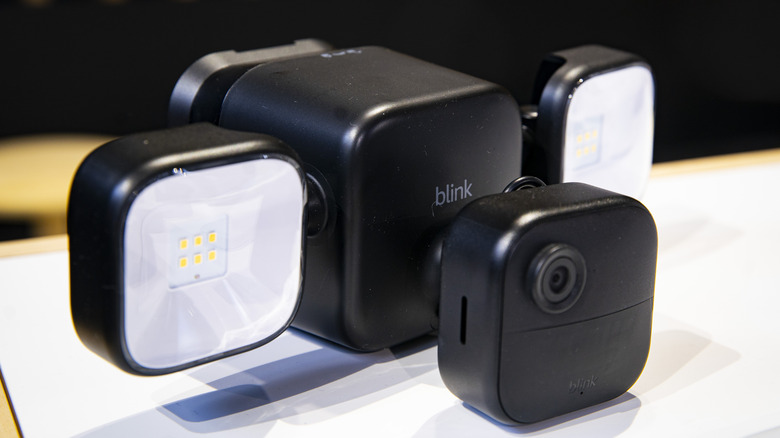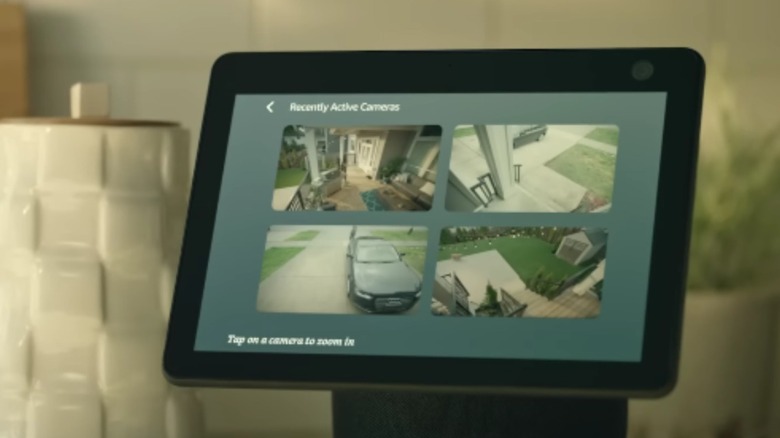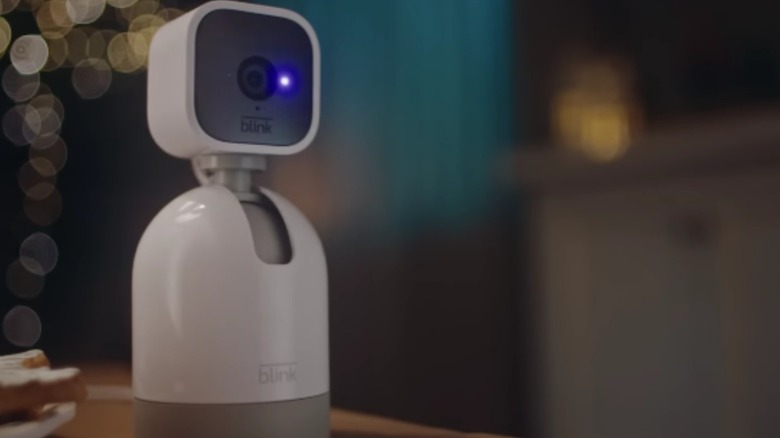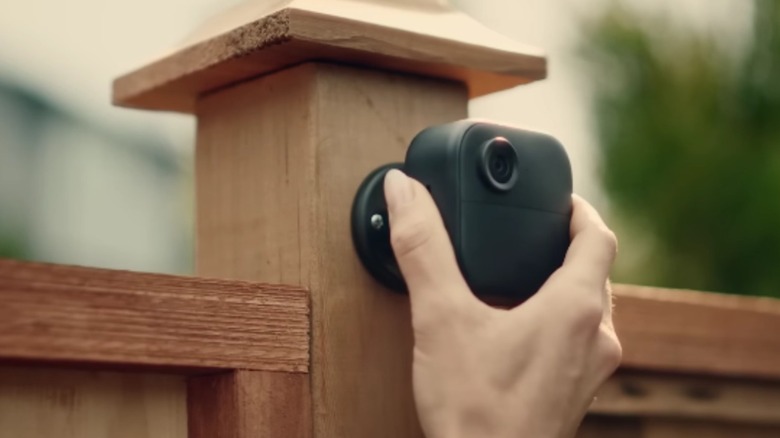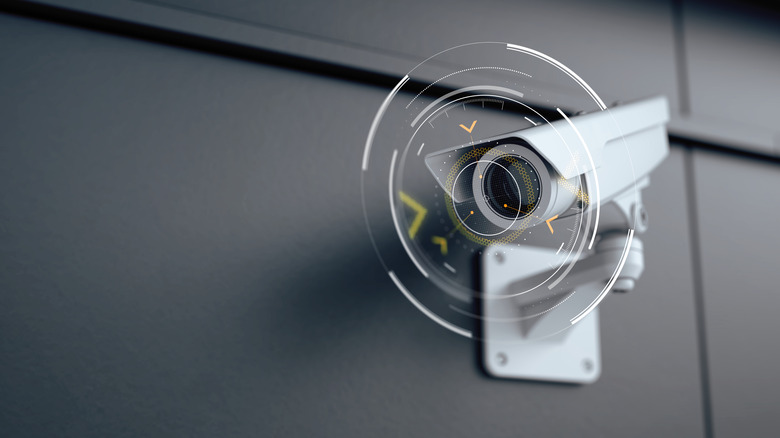The Best Places To Install Blink Security Cameras For Safety Monitoring
We may receive a commission on purchases made from links.
Whether you're away from home a lot or simply seeking the extra peace of mind, a security camera can be a fantastic investment. With handy app support, they're easier than ever to use, but it's important to choose the type of product that works best for you and to place it optimally.
A doorbell camera is wonderful for monitoring potential intruders and friendly package-delivers alike, and users can even speak through them to give instructions as to where to leave that precious cargo and so on. The downside of a doorbell camera, of course, is that they're very inflexible. What is a doorbell if it isn't attached to a door, after all? A more general security camera can be placed elsewhere as required, but you'll want it to get the best view while avoiding potentially monitoring your neighbors by mistake.
Here are some of the most effective places to install your Blink security camera, as well as some of the pitfalls and important considerations to bear in mind while doing so.
What types of cameras are offered by Blink?
The safety of your home, your family, and your property are matters to be taken with the utmost seriousness. As such, before taking the step of upgrading your existing Blink security camera(s) or investing in a new one, it's important to consider the types of cameras Blink offers.
From the Blink Wired Floodlight Camera to the Blink Mini Pan-Tilt, users can choose from a bright, motion-activated outdoor spotlight to a rather more subtle and far smaller rotating indoor camera, as well as options such as doorbell cameras. You can also meet in the middle with a Blink Outdoor 4 camera that you can place anywhere you want, and then supplement it with a DIY Blink Cameras add-on later on if you want. Naturally, though, not all of these options are going to be a fit for every home. What you'll want to do, then, is first consider perhaps the most basic of all location-based questions: do you want to monitor your property from the inside or the outside?
Maybe you've got a large yard you want to survey. Perhaps, alternatively, there are some precious items in your garage and you want to hide a small camera away in there for safety. With regards to installation locations, the matter of indoors or outdoors brings a lot of different factors into play. Let's take a look at indoor cameras and the concerns that come along with placing them first.
The best places to install indoor Blink cameras
There will typically be more surfaces to mount or stand a camera on inside, as well as more hidey holes to secret them in. The "busier" nature of indoor environments, however, brings up some concerns. Blink notes that motion detection works best when people pass across the field of view instead of getting closer from in front of it. If placing a camera in a hallway, then, it's recommended to install it in such a way that it has a central view of a high-traffic area rather than a view straight down from one end of the hall to the other.
Try to ensure that potential intruders can't pass by without activating it. A would-be burglar, of course, would be rather keen to take a camera out of commission if they fear they've been recorded by it, so Security.org further suggests angled placement as high as possible, so the camera can see as much and as safely as the architecture allows. You could install a small shelf high on a wall for just that purpose.
A very visible camera may act as a deterrent in itself, but there's another potential option: hiding the camera among furniture or other household items. If doing so, you'll want to ensure that it still has an unobscured view of the area (easily checked through the Blink app), not too close to any bright light sources or reflective surfaces that could obscure the feed.
The best places to install outdoor Blink cameras
With indoor cameras, there's no need to worry about matters such as the weather (though the weather-resistant properties of the Blink Outdoor 4 offer some more freedom in this regard). The likes of rain, snow, and fog can obscure a camera's view, and that familiar weather-based foe, condensation, can damage its components if it makes its way inside.
Sheltering outdoor devices from the elements is one factor to consider, and again, a higher position on your property is a safer place to do this (and will generally also afford greater visibility). Be mindful of the impact of the sun's passage across the sky, as not all Blink cameras can be aimed away from glare as flexibly as the indoor Blink Mini Pan-Tilt. Monitoring a feed will help you ensure that your camera is in the best place to provide 24/7 surveillance.
For Blink's floodlight-enabled devices, like the Outdoor 4 Floodlight Camera, a high and relatively safe location is similarly recommended. As these devices' bright spotlights make clear, though, they're intended to be highly effective deterrents, and to help with that goal, installing them in conspicuous spots is a great approach.
Vulnerable areas like windows and doors are the most important outdoor elements of a home to cover, so an unobscured view of them and their immediate surroundings should be prioritized. Lastly, be sure to consider how the space (or its contents) may change over the course of the day and night.
Privacy and other important considerations
With outdoor cameras in particular, it's vital to cover the key areas of your own property, but just as important not to encroach on anybody else's in the process. Again, users can't help the architecture of their homes, but Blink cameras offer Privacy Zones. Through them, certain areas that would otherwise be in a camera's view can be exempted from it. If the best view of your own doorway would also include your neighbor's, for instance, you can access the Privacy Zones settings through the Motion Zones settings in your camera, then drag on the on-screen image to block out certain areas from your camera's view.
There are some other issues that will further complicate the matter of Blink camera placement. Though installation on a higher surface is generally advised, Blink cautions that close proximity to walls and similar can affect the quality of your camera's sound playback.
Ultimately, it may not be practical to achieve a perfect environment for your camera. What you'll need to do is take these general concepts on board, experiment, troubleshoot any errors that may occur, and check your camera's feed, to ensure it works the best it can in the environment you've introduced it into.
